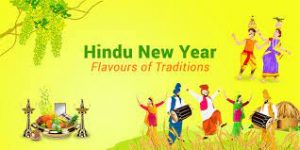New Year Festivals:

The Vice President of India greeted the people on festivals ‘Chaitra Sukladi, Gudi Padwa, Ugadi, Cheti Chand, Vaisakhi, Vishu, Puthandu, and Bohag Bihu’.
- These festivals of the spring season mark the beginning of the traditional new year in India.
Chaitra Sukladi:
- It marks the beginning of the new year of the Vikram Samvat also known as the Vedic [Hindu] calendar.
- Vikram Samvat is based on the day when the emperor Vikramaditya defeated Sakas, invaded Ujjain and called for a new era.
- Under his supervision, astronomers formed a new calendar based on the luni-solar system that is still followed in the northern regions of India.
- It is the first day during the waxing phase (in which the visible side of moon is getting bigger every night) of the moon in the Chaitra (first month of Hindu calendar).
Gudi Padwa and Ugadi:
- These festivals are celebrated by the people in the Deccan region including Karnataka, Andhra Pradesh and Maharashtra.
- The common practice in the celebrations of both the festivals is the festive food that is prepared with a mix of sweet and bitter.
- A famous concoction served is jaggery (sweet) and neem (bitter), called bevu-bella in the South, signifying that life brings both happiness and sorrows.
- Gudi is a doll prepared in Maharashtrian homes.
- A bamboo stick is adorned with green or red brocade to make the gudi. This gudi is placed prominently in the house or outside a window/ door for all to see.
- For Ugadi, doors in homes are adorned with mango leaf decorations called toranalu or Torana in Kannada.
Cheti Chand:
- Sindhis celebrate the new year as Cheti Chand. Chaitra month is called ‘Chet’ in Sindhi.
- The day commemorates the birth anniversary of Uderolal/Jhulelal, the patron saint of Sindhis.
Navreh:
- It is the lunar new year that is celebrated in Kashmir.
- It is the Sanskrit word ‘Nav-Varsha’ from where the word ‘Navreh’ has been derived.
- It falls on the first day of the Chaitra Navratri.
- On this day, Kashmiri pandits look at a bowl of rice which is considered as a symbol of riches and fertility.
Vaishakhi:
- It is also pronounced as Baisakhi, observed by Hindus and Sikhs.
- It marks the beginning of Hindu Solar New year.
- It commemorates the formation of Khalsa panth of warriors under Guru Gobind Singh in 1699.
- Baisakhi was also the day when colonial British empire officials committed the Jallianwala Bagh massacre at a gathering, an event influential to the Indian movement against colonial rule.
Vishu:
- It is a Hindu festival celebrated in the Indian state of Kerala, Tulu Nadu region in Karnataka, Mahé district of Union Territory of Pondicherry, neighboring areas of Tamil Nadu and their diaspora communities.
- The festival marks the first day of Medam, the ninth month in the solar calendar followed in Kerala.
- It therefore always falls in the middle of April in the Gregorian calendar on 14th or 15th April every year.
Puthandu:
- Also known as Puthuvarudam or Tamil New Year, is the first day of the year on the Tamil calendar and traditionally celebrated as a festival.
- The festival date is set with the solar cycle of the lunisolar Hindu calendar, as the first day of the Tamil month Chithirai.
- It, therefore, falls on or about 14th April every year on the Gregorian calendar.
Bohag Bihu:
- Bohag Bihu or Rongali Bihu also called Xaat Bihu (seven Bihus) is a traditional aboriginal ethnic festival celebrated in the state of Assam and other parts of northeastern India by the indigenous ethnic groups of Assam.
- It marks the beginning of the Assamese New Year.
- It usually falls in the 2nd week of April, historically signifying the time of harvest.




